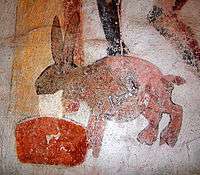Troll cat
A troll cat (also milk rabbit, troll ball) is the familiar of a witch in Scandinavian folklore. Either in the shape of a cat or a ball, troll cats sucked milk from cows and spat it out in the witches' milk pails, and went into homes to lick up cream. Related creatures are milk hares and milk rabbits.
Description
Witches reportedly were able to create them from "human hair, nails, wood shavings, and the like",[1] and they were said to suck milk from cows and steal cream from households.[2] Troll cats would then spit out the stolen milk into troughs next to the house.[3] The Norwegian names trollnøste and trollnøa indicate their shapes: those troll cats looked like balls of yarn.[4] Another type of troll cat had the shape of a regular cat; a difference between the two was that injury done to the cat-shaped troll cat would cause the same injury in the witch, whereas damaging the ball-shaped troll cat had no effect on her.[4] In addition, it was thought that shooting a troll cat would cause milk to spray from its wound.[5] The troll cat is easily confused with the witch's hug, which could also assume the shape of a cat.[4] The troll cat would have to be buried with the witch, or the witch would have to leave her grave to retrieve it.[4]
Peter Christen Asbjørnsen, a scholar of Norwegian folklore, retells a story in which Gypsies took advantage of farmers' beliefs in troll cats by stealing milk and blaming it on troll cats, a story they would then render believable by digging up a previously buried "bladder filled with red water surrounded by a cat-skin". Norwegian novelist Johan Bojer recalled an incident from 1914, when he was a lieutenant in the Army. The local women decided to raise the rent for the soldiers and he refused them permission to do so. He fell ill, and his three-day illness was explained by one of the women as a result of a troll cat having been sicced on him.[6]
A story collected in Norway, 1929, has a witch, named Lispet Snipånn, who had her farmhand collect all the wood shavings; on Thursday night she would roll them into a ball and put three drops of blood (from her finger) on it. The incantation "Now I have given you flesh and blood. May Old Nick give you power and life" turned the ball into a troll cat.[1] Another spell was recorded in Sweden, 1908:
- I give you blood,
- Satan gives you power.
- You shall run for me on earth,
- I shall burn for you in hell.
- You shall travel through forests and fields,
- gathering milk and cream.[7]
Such invocations to Satan were necessary because the witch herself was unable to give life to any of her creations. Droppings from the troll cat (or, the excess milk they had lapped up too greedily and vomited up) could, if they were burned, cause the witch to feel sympathetic pain.[4]
A related creature is the tilberi, a milk thief and witches' aide in Icelandic folklore. The tilberi (also called snakkur, a spindle "made from a dead man's rib, stolen wool, and communion wine") plays the same role as the troll cat. One Icelandic farmer chased one on horseback and at long last it hid under the skirts of a farmer's wife. The skirt was tied up so the thief couldn't escape, and the woman was burned.[8]
Explanation
The existence of troll cats appears to be related to the observation of matter (such as hair) regurgitated by cattle.[1] The slime mold Fuligo septica and the foam made by spittle bugs were seen as troll cat droppings.[9] Also offered as an explanation for the belief in troll cats is the Norwegian Forest Cat, a particularly long-haired cat native to Northern Europe.[10]
References
Notes
- Kvideland and Sehmsdorf 176.
- Kvideland and Sehmsdorf 177.
- Lecouteux, ch. 5
- Alver 120.
- Simpson 174.
- Hult 222 n.22.
- Kvideland and Sehmsdorf 176-77.
- Kvideland and Sehmsdorf 179.
- Kvideland and Sehmsdorf 178.
- Taylor 76.
Bibliography
- Alver, Bente G. (1989). Kvideland, Reimund; Sehmsdorf, Henning K.; Simpson, Elizabeth (eds.). Nordic Folklore: Recent Studies. Bloomington: Indiana UP. pp. 110–28. ISBN 9780253205216.
- Hult, Marte H. (2003). Framing a National Narrative: The Legend Collections of Peter Christen Asbjørnsen. Detroit: Wayne State UP. ISBN 9780814330067.
- Kvideland, Reimund; Sehmsdorf, Henning K. (1988). "39. Troll Cat". Scandinavian Folk Belief and Legend. Minneapolis: U of Minnesota P. pp. 175–79. ISBN 0816619670.
- Lecouteux, Claude (2013). "5. Domestic Spirits in Antiquity and the Middle Ages". The Tradition of Household Spirits: Ancestral Lore and Practices. Inner Traditions / Bear & Co. ISBN 978-1620551448.
- Simpson, Jacqueline (2004). "5. Black Magic". Icelandic Folktales and Legends. Los Angeles: U of California P. ISBN 0520021169.
- Taylor, David (1989). "Norwegian Forest Cat". The Ultimate Cat Book. New York City: Simon & Schuster. p. 76. ISBN 9780671686499.

